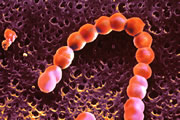Bacteria hijack a human protein and use it to penetrate through the defense of blood clots.

Streptococcus bacteria
According to American researchers, it was found that bacteria can use our own system to dissolve blood clots to spread in the body. The researchers hope their findings will be used to design drugs or vaccines to prevent certain types of terminal infection.
Group A Streptococcus (GAS) infections are common infections, and usually cause nothing more than a sore and sensitive throat. Occasionally, however, these bacteria manage to spread through the body quickly, and when they do, it can lead to death in more than 25% of cases.
The body reacts to GAS by building blood clots around the infected area, and surrounding the bacteria between the blood clots. However, the bacteria return fire... they release an enzyme, called streptokinase, which causes the body to break down the blood clots, thus allowing the bacteria to escape everywhere and multiply throughout the body. In such cases, patients may suffer from the phenomenon of necrotizing fasciitis - the "meat digestion" disease.
David Ginsburg and his colleagues from the University of Michigan, deciphered exactly how streptokinase does this. It activates a protein called plasminogen, which starts the chain of reactions that makes the blood clot more soluble, until it dissolves. Inactive plasmin is naturally stored in the body until it is needed. However, the bacterial streptokinase stimulates the release of the protein from the clot solution, thus removing the barrier that kept the infected area under control and limited, preventing the spread of the bacteria throughout the body. The study was published in the journal Science.
super mouse
The researchers' discovery explains why the humble laboratory mouse is so generally resistant to GAS. The murine plasminogen is different from the human one, and is not recognized as a target by the streptokinase; GAS only causes local infections when injected under the skin into laboratory mice, because the enzyme is unable to cause blood clots to dissolve in the mouse.
To understand why, Ginsburg took genetically engineered mice whose coagulation mechanism control involves human plasminogen and injected them with GAS. The bacteria went rampant and multiplied rapidly in the mice, killing all the mice tested.
So Ginsburg repeated the experiment, but used transgenic GAS bacteria, from which the streptokinase gene had been removed. This time, the mice suffered only local infections, and none died. This pinpoints the interaction between streptokinase and human plasminogen as the source of the bacteria's spread throughout the body.
Such knowledge may lead to a vaccine that will block streptokinase and stop the spread of the bacterium, says Olaf Sjobring, a microbiologist at Lund University in Sweden, who took part in the research group.
"The data are very promising," says Stefan Normark, an expert in GAS infections at the Karolinska Institute in Stockholm, Sweden. "There is real enthusiasm in the field about producing virulence inhibitors. This may be a breakthrough, but we will have to wait and see," he adds.
Super bacteria
Scientists now assume that other deadly bacteria spread and cause infections in a similar way. The strain of the superbug known as Staphylococcus aureus-methicillin-resistant MRSA, which causes very serious infection problems in hospitals (a predatory bacterium...), also relies on an enzyme that activates plasminogen. So Ginsburg's discovery may help curb these types of pollution as well, Sjobring says.
One mystery still remains: why does GAS cause serious problems only in some patients? If GAS is able to cause such severe damage, and dissolve blood clots around a local infection, why does this not happen every time the bacteria infects a certain person, but only in a small number of cases? Ginsburg thinks this is because there are slight differences between the genes for plasminogen in different people. The result of this genetic variation is that among different patients the structure of the plasminogen protein is different. The difference in the structure means that in some cases the structure is recognized by the bacterial enzyme, and in some cases - not (similar to the experiment with the laboratory mice, which have mouse plasminogen). It is possible that in the future it will be possible through a genetic test to identify the people who have the gene for plasminogen that can be activated by GAS and to treat this risk group with preventive treatment.
